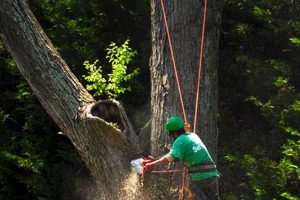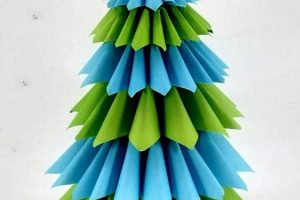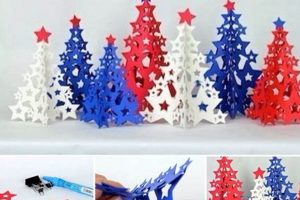Creating a personalized holiday centerpiece through crafting a ceramic evergreen during the Yuletide season allows for unique decorative expression. These projects involve shaping, firing, and painting clay into a festive tree form, often embellished with miniature lights and colorful adornments. The process offers a tangible outcome from artistic endeavor.
The appeal stems from the customization possibilities and the creation of a treasured heirloom. Such handcrafted decorations provide an alternative to mass-produced items, fostering a sense of accomplishment and offering a distinctive aesthetic. Historically, these projects echo traditional holiday craft practices, representing a return to personalized home decor.
The subsequent sections will detail the necessary materials and equipment, provide step-by-step instructions for constructing the base and adding embellishments, and explore various design options and finishing techniques to complete this festive craft.
Crafting a Lasting Heirloom
The creation of ceramic holiday trees demands attention to detail and a considered approach. The following tips will aid in producing a durable and visually appealing finished product.
Tip 1: Clay Selection: Employ a mid-range earthenware or stoneware clay body specifically formulated for hand-building. This ensures adequate workability and minimizes cracking during the drying and firing processes.
Tip 2: Consistent Wall Thickness: Maintain a uniform clay thickness throughout the construction. Variable thicknesses lead to uneven drying and potential structural weaknesses during firing. Aim for approximately 1/4 to 3/8 inch thickness.
Tip 3: Slow and Even Drying: Allow the formed tree to dry slowly and evenly under plastic or within a damp box to prevent warping and cracking. Rapid drying causes undue stress on the clay structure.
Tip 4: Proper Firing Temperature: Adhere strictly to the clay manufacturer’s recommended firing temperature range. Under-firing results in a fragile piece; over-firing can cause melting and deformation.
Tip 5: Glaze Compatibility: Select glazes that are chemically compatible with the chosen clay body. Incompatibility can lead to crazing, shivering, or blistering of the glaze surface. Perform test firings to confirm compatibility.
Tip 6: Secure Bulb Attachment: When incorporating miniature bulbs, ensure they are securely affixed to the tree using ceramic adhesive or low-fire epoxy. This prevents bulbs from detaching and posing a safety hazard.
Tip 7: Careful Handling: Fired ceramic is brittle. Handle the completed tree with care to avoid breakage, particularly during storage and display. Employ a protective storage container when not in use.
Adhering to these guidelines will contribute significantly to the successful creation of a lasting and aesthetically pleasing ceramic holiday decoration.
With these tips in mind, the article will now proceed to exploring advanced design techniques and troubleshooting common challenges encountered during the construction process.
1. Clay body selection
Clay body selection is a foundational element in the successful execution of a ceramic evergreen. The chosen clay directly influences the structural integrity, firing behavior, and final aesthetic of the finished piece. An inappropriate clay body can lead to cracking, warping, or even complete structural failure during the firing process, rendering the creation unusable. For example, a low-fire earthenware clay, while easily workable, may not withstand the repeated heating and cooling cycles associated with long-term display with electric lights, potentially leading to gradual degradation. Conversely, a high-fire porcelain, while strong and durable, presents significant challenges in terms of workability for intricate designs and requires specialized kiln capabilities beyond the reach of many home-based craftspeople.
The practical significance of proper clay body selection is evident in the longevity and aesthetic appeal of the decorative item. A mid-range stoneware, for instance, offers a balance between workability and durability, allowing for detailed sculpting and reliable performance in a home kiln environment. Furthermore, the clay’s color and texture influence the glaze’s appearance. A dark clay body under a translucent glaze will produce a different visual effect compared to a light-colored clay. Consequently, selection necessitates considering not only the technical properties of the clay but also its compatibility with the intended glazing and decorative techniques. A potter selecting a clay body should consider the specific firing range, shrinkage rate, and water absorption properties, ensuring these align with the design and intended use of the ceramic holiday tree.
In conclusion, the selection of a clay body is a critical determinant of success. Understanding the interplay between the clay’s properties, the firing process, and the desired aesthetic outcome is paramount. Overlooking this fundamental aspect increases the risk of structural failure, compromised visual appeal, and ultimately, the creation of a substandard holiday decoration. Careful consideration and informed decision-making in clay selection are thus indispensable for crafting a lasting and cherished ceramic heirloom.
2. Mold creation/selection
Mold creation or selection forms a pivotal stage in the construction of a ceramic evergreen, significantly influencing the final shape, texture, and replicability of the decorative item. The mold acts as a template, defining the physical parameters of the clay form before firing. Whether a pre-existing mold is employed or a custom mold is fabricated, this decision profoundly impacts the creative process and the outcome.
- Pre-Existing Mold Utilization
Employing commercially available slip-casting molds offers consistency and efficiency in reproducing identical forms. These molds, typically made of plaster, absorb water from the liquid clay slip, facilitating hardening and demolding. The use of pre-existing molds, however, limits design customization to surface decoration and glazing techniques. An example is utilizing a classic, multi-piece mold to achieve the traditional tiered tree shape, allowing for variations only in painted color schemes and added light attachments.
- Custom Mold Fabrication
Crafting a custom mold allows for complete design freedom and the creation of unique and intricate shapes. This process involves sculpting a master model from clay, plaster, or other materials, then using this model to create a multi-part mold. While offering greater design control, custom mold creation requires specialized skills and equipment, including sculpting expertise and mold-making materials. A custom-designed mold could replicate a stylized tree silhouette with asymmetrical branches or incorporate specific geometric patterns not found in commercially available molds.
- Material Selection for Mold Making
The material used for mold construction significantly affects its durability, detail capture, and ease of use. Plaster, a common choice, is absorbent and cost-effective but can be prone to chipping and wear over time. Silicone molds, while more expensive, offer greater flexibility and detail reproduction, enabling the replication of intricate textures and undercuts. The selection of material hinges on the complexity of the design and the anticipated number of uses. A highly detailed, one-off design would benefit from a silicone mold to capture fine features, whereas a simpler design intended for mass production might utilize a more robust plaster mold.
- Mold Release Techniques
Successful demolding without damaging the clay form requires the application of appropriate mold release agents. These agents, typically applied to the inner surface of the mold, prevent the clay from sticking and facilitate clean separation. Examples include petroleum jelly, silicone sprays, or commercially available mold release compounds. Improper use or omission of a mold release agent can result in tearing, distortion, or breakage of the clay form during demolding, necessitating rework or discarding the piece.
In essence, the mold acts as the foundational framework for the ceramic evergreen. Whether selecting a ready-made mold or embarking on the process of custom fabrication, careful consideration of the design requirements, mold material properties, and demolding techniques is paramount. Mastery of this phase significantly contributes to the overall success of the ceramic holiday project, enabling the creation of both standardized and uniquely personalized festive decorations.
3. Firing temperature control
Firing temperature control constitutes a critical variable in the creation of a durable and aesthetically pleasing ceramic evergreen. Precise regulation of kiln temperature during the firing cycle directly influences the vitrification of the clay body, the maturation of glazes, and the overall structural integrity of the finished piece. Deviation from recommended firing schedules can result in defects ranging from under-fired, fragile pieces to over-fired, deformed objects.
- Clay Body Vitrification
Vitrification, the process of partial fusion in clay, strengthens the ceramic material by reducing its porosity. Insufficient firing temperatures prevent proper vitrification, resulting in a weak and porous final product susceptible to cracking and water damage. A ceramic evergreen under-fired in this manner would be more vulnerable to breakage during handling and less resistant to environmental conditions. Conversely, excessive firing leads to over-vitrification, causing slumping and distortion of the form, potentially rendering it unusable as a decorative item.
- Glaze Maturation
Glazes are formulated to mature within specific temperature ranges, achieving their intended color, texture, and surface finish. Under-fired glazes may appear dull, powdery, and lack the desired color saturation, compromising the aesthetic appeal of the finished tree. Over-fired glazes can run, blister, or undergo unwanted color changes, similarly detracting from the visual quality. Successful glaze application is contingent on achieving the precise temperature required for the glaze composition to properly melt and fuse to the clay surface.
- Structural Stability and Warpage
Maintaining consistent temperature control is essential for minimizing warping and cracking during the firing process. Uneven heating or cooling rates create stress within the clay body, leading to deformation or structural failure. Rapid temperature changes, particularly during critical stages of the firing cycle, can induce thermal shock, resulting in cracking or shattering. A controlled firing schedule, with gradual temperature increases and decreases, mitigates these risks and promotes uniform stress distribution within the ceramic piece.
- Electrical Component Integration
Many ceramic evergreens incorporate electrical components, such as miniature lights, for illumination. Excessive firing temperatures can damage these components or compromise their functionality. Therefore, it is crucial to fire the ceramic tree to a temperature suitable for the clay and glaze, while remaining within the safe operating range of any embedded electrical elements. This often necessitates bisque firing the ceramic piece before adding the lights and then completing a lower-temperature glaze firing to avoid damaging the electrical parts.
In summary, the firing temperature constitutes a pivotal parameter in crafting a ceramic evergreen. Careful monitoring and control of the kiln temperature are essential for achieving optimal clay vitrification, glaze maturation, structural stability, and compatibility with integrated electrical components. Adherence to recommended firing schedules significantly enhances the durability, aesthetic appeal, and functionality of the resulting holiday decoration, transforming raw clay into a cherished ceramic heirloom. This precision ensures the desired outcome, preventing defects and preserving the integrity of the final product.
4. Glaze application technique
Glaze application technique is a fundamental aspect in the creation of a ceramic holiday tree, significantly influencing the aesthetic appeal and durability of the finished product. The method by which glaze is applied directly impacts the color intensity, surface texture, and overall visual impression of the tree.
- Brushing
Brushing involves applying glaze with a brush, offering a high degree of control over placement and layering. This technique is particularly suitable for detailed work, such as highlighting specific areas or creating intricate patterns. However, brushing can result in uneven coverage and brushstrokes if not executed carefully. For a decorative tree, brushing might be used to apply a contrasting color to the tips of the branches, creating a snow-dusted effect.
- Dipping
Dipping involves immersing the ceramic tree in a glaze bath, providing a uniform coating over the entire surface. This method is efficient for covering large areas and achieving consistent results. However, it requires a large volume of glaze and may not be suitable for complex shapes or pieces with delicate details. A simple, single-color tree could be effectively glazed using the dipping technique.
- Spraying
Spraying employs an airbrush or spray gun to apply a fine mist of glaze onto the ceramic surface. This technique allows for smooth, even coverage and is ideal for creating subtle color gradients or blending different glazes. Spraying requires specialized equipment and a well-ventilated area, but it offers versatility and control over the glaze application. Creating an ombre effect on a ceramic evergreen, transitioning from a dark green base to a lighter green top, is achievable through spray application.
- Pouring
Pouring involves carefully pouring glaze over the ceramic surface, allowing it to flow and coat the piece. This method can create interesting textures and patterns as the glaze pools and drips. However, pouring requires skill and experience to control the flow and prevent excessive glaze buildup. For instance, pouring a thick, textured glaze over the tree can create a rustic, handcrafted appearance.
The selection of a specific glaze application technique is dependent upon the desired aesthetic effect, the complexity of the design, and the available resources. A skilled artisan tailors the application method to achieve the intended visual outcome, enhancing the beauty and longevity of the ceramic holiday decoration. Each technique offers a unique set of advantages and considerations, contributing to the personalized character of the final product.
5. Light fixture integration
Light fixture integration is a critical component in the creation of a functional and aesthetically pleasing ceramic holiday tree. The incorporation of illumination enhances the visual appeal of the decoration, transforming it from a static clay form into a dynamic and festive display. Thoughtful planning and execution are essential for safe and effective integration.
- Socket Selection and Placement
The selection of appropriate sockets is paramount. Candelabra-based sockets are commonly used due to their compact size and compatibility with readily available miniature bulbs. Socket placement should be strategically planned to distribute light evenly throughout the tree, highlighting its form and decorative details. Inadequate planning can result in uneven illumination or unsightly wiring.
- Wiring and Electrical Safety
Proper wiring techniques and adherence to electrical safety standards are non-negotiable. Only UL-listed wiring and components should be used. Connections must be secure and insulated to prevent short circuits or electrical hazards. The use of a polarized plug is recommended to ensure proper grounding. Ignorance of electrical safety principles can lead to fire hazards and personal injury.
- Bulb Type and Wattage Considerations
The choice of bulb type and wattage directly impacts the overall brightness and heat generated by the light fixture. Incandescent bulbs, while providing a warm glow, produce significant heat, potentially damaging the ceramic structure or posing a fire risk. LED bulbs offer a cooler, more energy-efficient alternative. Bulb wattage should be carefully selected to avoid overloading the circuit and to ensure compatibility with the chosen sockets and wiring.
- Access and Maintenance
Designing for accessibility and ease of maintenance is crucial for long-term functionality. The light fixture should be easily accessible for bulb replacement and troubleshooting. A removable base or access panel can facilitate these tasks. Neglecting accessibility can result in frustration and difficulty in maintaining the illumination system, shortening the lifespan of the ceramic holiday tree as a functional decoration.
The successful integration of light fixtures into a ceramic holiday tree necessitates a comprehensive understanding of electrical principles, component selection, and safety considerations. By prioritizing safety, accessibility, and aesthetic harmony, a crafter can create a festive and functional holiday decoration that provides years of enjoyment.
6. Surface decoration options
Surface decoration options represent a critical stage in the personalization of a handcrafted ceramic holiday tree. The techniques employed during this phase determine the final aesthetic and distinguish each piece as a unique creation. Surface decoration transforms the blank ceramic form into a festive holiday centerpiece.
- Underglaze Painting
Underglaze painting involves applying colored pigments to the bisque-fired ceramic surface before the final glaze firing. This technique allows for detailed imagery and precise color control. The subsequent clear glaze firing seals the underglazes, protecting them from wear and enhancing their vibrancy. A ceramic evergreen could be decorated with detailed holly leaves and berries using underglaze paints before being covered with a clear, glossy glaze.
- Overglaze Decoration
Overglaze decoration, also known as china painting, is applied on top of a previously glazed and fired surface. This method uses specialized overglaze paints that are fired at a lower temperature than the base glaze. Overglaze allows for intricate detail and delicate color layering. For example, gold luster accents can be added to the tips of the ceramic tree’s branches to create a shimmering effect after the final glaze firing.
- Textural Techniques
Textural techniques involve altering the surface of the clay to create tactile and visual interest. Impressing patterns, carving designs, or applying textured slips before firing adds depth and dimension to the ceramic tree. A crafter might use a lace doily to impress a delicate pattern onto the clay surface before bisque firing, resulting in a tree with an elegant, textured surface after glazing.
- Decal Application
Decal application offers a method for transferring pre-printed images onto the ceramic surface. Ceramic decals are applied to the glazed surface and then fired at a low temperature to fuse the image to the glaze. This technique enables the incorporation of complex designs and photographic imagery. Holiday-themed decals, such as snowflakes or vintage ornaments, can be applied to the ceramic evergreen to create a nostalgic or festive aesthetic.
These varied surface decoration options provide a broad palette for individual expression in the creation of ceramic holiday trees. The selection and skillful application of these techniques are instrumental in transforming a simple ceramic form into a personalized and cherished holiday decoration. Experimentation with different techniques yields a diverse range of aesthetic results, reflecting the unique vision and artistry of the craftsperson.
7. Structural integrity
Structural integrity is paramount in the context of a ceramic holiday tree. This refers to the capacity of the finished piece to withstand physical stresses during handling, display, and storage without cracking, breaking, or collapsing. The absence of adequate structural integrity renders the decorative item fragile, limiting its lifespan and diminishing its aesthetic value. Consider, for example, a tree constructed with uneven wall thicknesses; this introduces stress points, increasing the likelihood of cracking during firing or subsequent handling. Similarly, improper clay selection, such as using a clay body unsuitable for the intended size and complexity of the design, can compromise the overall strength of the piece. These factors demonstrate the direct cause-and-effect relationship between construction techniques and structural resilience.
Achieving adequate structural integrity involves careful consideration of several key factors throughout the creation process. The clay body must be appropriate for the intended size and shape. Consistent wall thickness, achieved through meticulous hand-building or slip-casting techniques, is essential for even stress distribution. Slow and controlled drying prevents the formation of stress cracks. Proper firing to the clay’s recommended temperature ensures adequate vitrification, strengthening the ceramic matrix. Additionally, the design itself plays a crucial role; sharply angled branches or unsupported overhangs create inherent weak points, necessitating reinforcement or design modifications. A practical example involves a ceramic artist reinforcing delicate branches with strategically placed internal supports during the construction phase, thereby increasing the tree’s resistance to breakage.
In conclusion, structural integrity is not merely a desirable attribute but a fundamental requirement for a successful project. Addressing potential weaknesses through informed material selection, careful construction, and meticulous firing practices ensures the creation of a lasting and cherished ceramic heirloom. The challenges of achieving this integrity underscore the importance of understanding ceramic principles and applying them diligently throughout the creation process, ultimately linking directly to the longevity and enjoyment derived from the finished holiday decoration.
Frequently Asked Questions
This section addresses commonly encountered queries regarding the construction and finishing of ceramic holiday trees. The information presented aims to clarify technical aspects and provide practical guidance.
Question 1: What clay body is most suitable for constructing a durable ceramic holiday tree?
A mid-range stoneware clay body is generally recommended due to its balance of workability and fired strength. Earthenware is more easily worked but less durable; porcelain offers greater strength but requires higher firing temperatures and presents forming challenges. Stoneware provides a compromise suitable for most home studio setups.
Question 2: How can cracking during the drying process be minimized?
Slow and even drying is crucial. The formed tree should be covered with plastic or placed within a damp box to prevent rapid moisture loss. Direct sunlight and drafts should be avoided. Thicker sections may require longer drying times.
Question 3: What firing temperature should be used for a ceramic holiday tree?
The appropriate firing temperature depends on the chosen clay body and glaze. The clay manufacturer’s recommendations should be strictly followed. Generally, a cone 5-6 firing (approximately 2167-2232F or 1186-1222C) is suitable for mid-range stoneware. Test firings are recommended to verify temperature accuracy and glaze performance.
Question 4: How can a uniform glaze application be achieved?
Dipping or spraying are the most effective methods for achieving uniform glaze coverage. Brushing can be used for detail work, but multiple thin coats are necessary to avoid brushstrokes and unevenness. Proper glaze viscosity and surface preparation are also important factors.
Question 5: What are the key safety considerations when integrating electrical components?
Only UL-listed wiring and sockets should be used. All connections must be secure and properly insulated. The wattage of the bulbs must be compatible with the wiring and sockets. A polarized plug is recommended. Electrical work should be performed in accordance with local electrical codes.
Question 6: How can the finished ceramic holiday tree be protected from damage during storage?
The tree should be stored in a sturdy container with adequate padding to prevent impacts and abrasion. Individual components, such as light bulbs, should be removed and stored separately. The tree should be kept in a dry environment to prevent moisture damage.
Consistent application of these principles enhances the likelihood of creating a durable and visually appealing ceramic holiday tree. Proper execution is paramount for a long-lasting decorative item.
The following section will detail the supplies and tools necessary for creating this type of holiday decoration.
Concluding Remarks on Constructing a Personalized Ceramic Evergreen
This exploration has outlined fundamental considerations for undertaking a project focused on creating a holiday decoration. It emphasized material selection, temperature control, structural design, and aesthetic finishing. Proper execution of each stage is paramount to achieving a lasting and visually appealing result. Each step is important for making sure the product is worth using.
Future endeavors in this craft may focus on innovative design approaches and enhanced material utilization. Continued refinement of these techniques will contribute to the creation of increasingly sophisticated and durable holiday decorations. The craft of creating a unique decoration provides a tangible link to holiday traditions and artistic expression. Therefore it should continue to live on.







